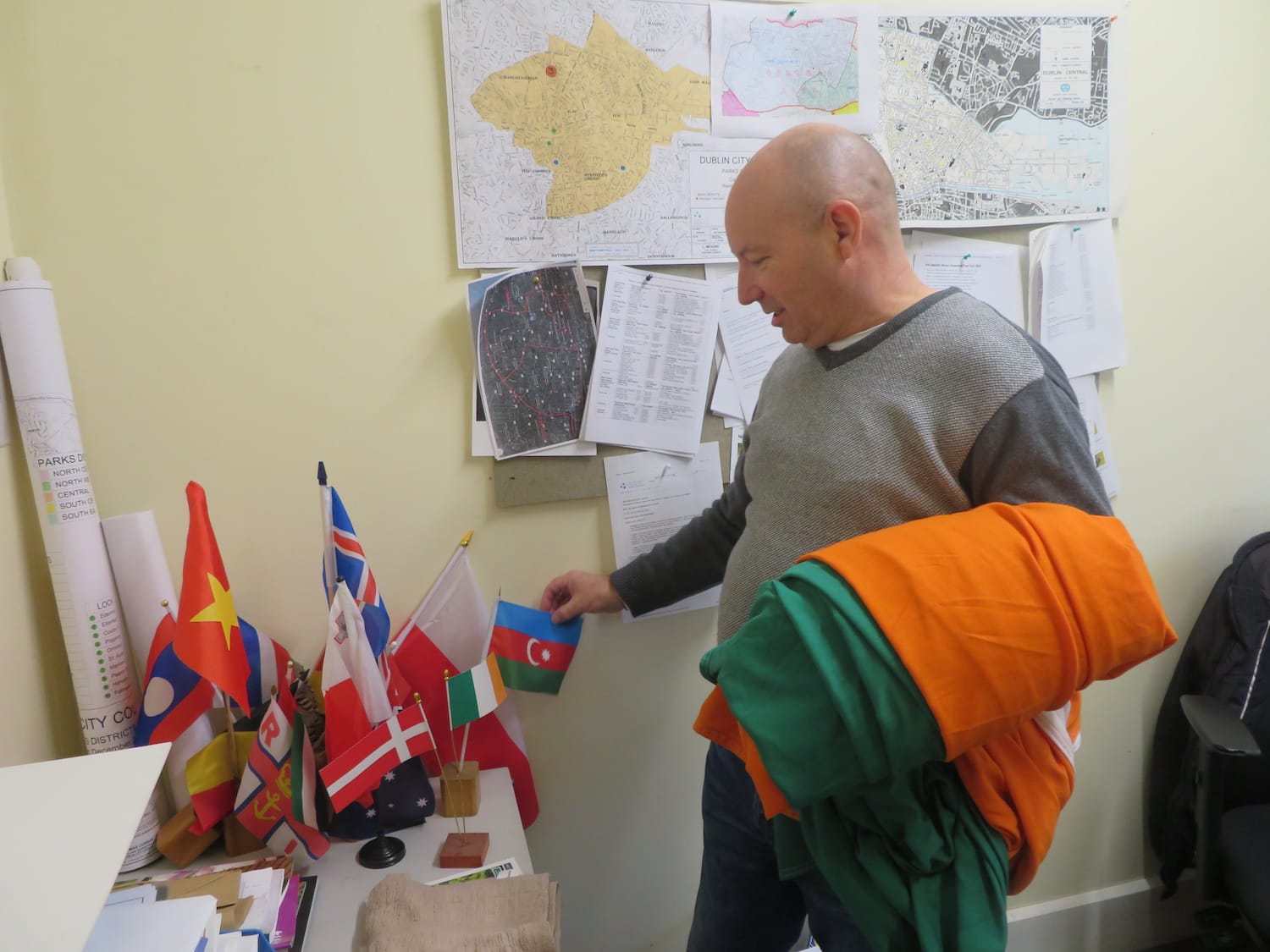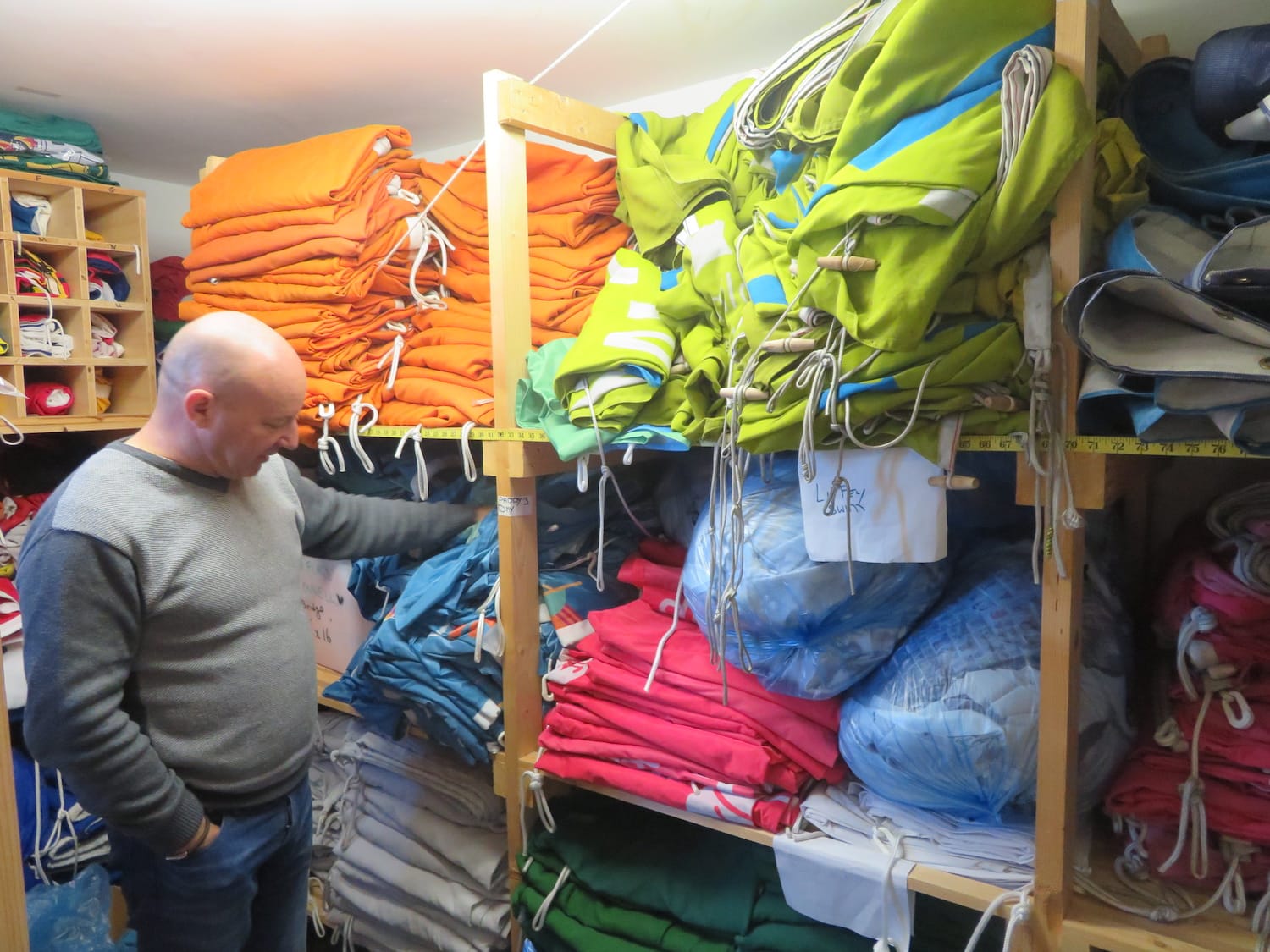What’s the best way to tell area residents about plans for a new asylum shelter nearby?
The government should tell communities directly about plans for new asylum shelters, some activists and politicians say.
These days it’s Ed Bowden, a member of Vexillology Ireland, who’s in charge of the city’s flags, including the tricolour fluttering over Dame Street.

When Ed Bowden was a child, it was unusual to see the Irish tricolour flying in people’s homes or on scattered state buildings, he says. Save, of course, for the Dáil.
But his family had a flagpole with a tricolour in the garden. As did his grandfather. Bowden, unsurprisingly perhaps, developed an interest in flags from a young age.
“My favourite subject was geography. I loved travelling and I suppose flags go with that,” says Bowden, a senior district parks officer with Dublin City Council.
Inside his office in the Lodge House in Blessington Street Park, behind the computer, are two miniature flags, on two tiny flag poles: a tricolour and the pride flag.
On top of a filing cabinet in the corner are around 20 small flags from countries he has visited. One blue, yellow and green with a crescent moon from Azerbaijan. Another red with a yellow star from Vietnam.
Bowden, a member of Vexillology Ireland, an association for people who are interested in flags, studied horticulture in college and then got a job in the parks department of Dublin City Council.
“When I got the job in here I got responsibility for flags, which was very odd,” he says, happily. Bowden, these days, is responsible for all the city council flags – including the one that flutters from the roof of City Hall.
As such, he was intrigued to learn that the 100-year anniversary of the first time the tricolour was hoisted over Dublin’s City Hall is next week.
The first record of the tricolour flying over City Hall is from 30 January 1920, says Bernard Kelly, a historian in residence with Dublin City Council.
That was an act of defiance and part of a symbolic battle for control of the largest local authority in Ireland, Kelly says.
“Because City Hall is so close to Dublin Castle, the seat of the British administration in Ireland, the hoisting of that flag would have been a real kick in the face,” he says.
“I’ve no record of who ordered it and there is no record of how it came about,” says Kelly, of the first hoisting.
He’s written a chapter on the history of Dublin Corporation – as the city’s local government was then known – during the War of Independence in the council-published History on Your Doorstep.
“All we have is the front page of the Examiner showing that the tricolour was hoisted over City Hall in place of the municipal flag,” he says.
The flag was certainly hoisted in order to welcome the new council to their first meeting on 1 February, he says. The local elections in 1920 had ushered in a starkly different council to one that had preceded it.
“These are heavy duty republicans and they pushed the council away from its old moderate roots in a very radical direction,” he says.

The new council included William Cosgrave – who was also a TD and an Irish Volunteer – Jennie Wyse Power, John Bohan and Michael Staines, he says.
The minutes of the meetings don’t mention the flying of the tricolour at all, but other symbolic events were recorded soon after, Kelly says.
“On the 30 February a motion was passed that the British royal sword and mace be removed from the chamber,” he says. They symbolised that the meeting was happening under the authority of the crown, he says.
The motion said that the sword and mace were “relics of barbarism originating in the desire of tyrannical monarchs to parade their power before the eyes of a subject people”, he says.
That repudiation of royal authority was a major symbolic victory, Kelly says. And Sinn Féin pushed through several other motions.
For example, they changed the names of streets, with Great Brunswick Street becoming Pearse Street. All those symbolic actions were very significant, says Kelly. “It is seizing control of the landscape,” he says.
The motions the councillors passed were entered in the minutes and then reported in the newspapers, which provided great publicity for the movement, he says.
“If the IRA are physically challenging the British for control of the streets, Sinn Féin are challenging them politically,” he says, and where better to do that than within Dublin Corporation?
“Dublin Corporation is the biggest city council in the country,” says Kelly. “If Sinn Féin can be seen to capture Dublin it is a major thing.”
“If they can capture Dublin, they can capture Cork and then the other cities. It is a big piece of the puzzle,” says Kelly.
Back in the Lodge House in Blessington Street Park, Bowden’s storage room is packed with flags of every colour: Liffey Swim flags, Euro 2020 flags, and the flags of the four provinces, the 32 counties and a wide assortment of nations.

Bowden pulls out a white, blue and red Russian flag and holds it out. It is six feet long and three feet wide, he says.
“The national flags are all hand-stitched,” he says, pointing to the white-threaded seam on the Russian flag. “That is the way a formal flag should always be.”
Some other flags can be purchased cheaply as prints, but not national flags, in case you get the shade wrong, he says.
“The green for Ireland is totally different from the green for Italy,” he says. “The Italian one is more olive green, it is deeper.”
When he took over responsibility for flags in the council, they didn’t actually fly the tricolour over City Hall, he says.
They used to fly the Dublin flag and the EU flag. “There is a protocol from the Taoiseach’s office, an old protocol, that means the [national] flag shouldn’t be left up overnight,” Bowden says.
But hoisting a flag on City Hall means climbing up ladders to get onto the roof, he says. That depends on the weather.
“For that reason we never flew the Tricolour on any of our buildings up until about eight years ago,” he says.
In recent years, the council made a new deal with the Taoiseach’s office, letting them leave the tricolour up if they floodlit the flagpole. “So you are showing a bit of respect. It is not left up in the dark,” he says.
Sign up here to get our free email newsletter each Wednesday, with headlines from the week’s online edition, updates from inside the newsroom, and more. It’s a little reminder when we have a new edition out, and a way for you to stay in touch with what we’re doing without having to check social media.
Get our latest headlines in one of them, and recommendations for things to do in Dublin in the other.